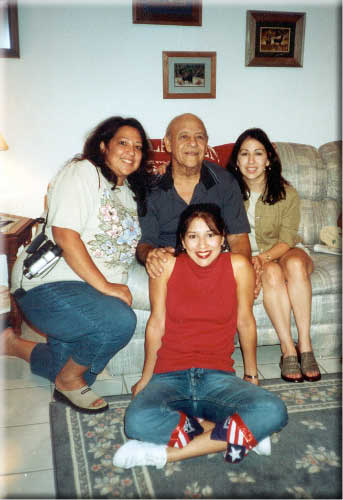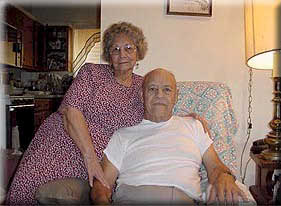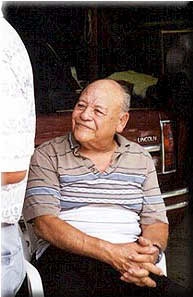Plumber Explores Treatment With Alimta
Ralph Lerma, a 78 year-old plumber, was diagnosed with malignant mesothelioma of the pleura in September, 2000. He and his wife Inez reside in Kingsville, Texas.
A couple of years ago, Mr. Lerma was still working in his business, Central Plumbing & Heating. Mr. Lerma worked at least 40 and sometimes 50 hours a week. After a while, he began to notice that he was "slowing down." He thought it was because of his age, even though he was used to working all the time. Before he began to slow down, he would dig "tunnels" to re-route pipe from pipe which had corroded under a building. Last year, he started hiring someone to perform the tunneling work.
In February, 2000, Mr. Lerma's stamina declined further, this time sharply, and he was "a little" short of breath. A man with a high pain threshold, he simply told his wife Inez that he was feeling tired, and she told him that he better go see the doctor. Inez recalls, "He never complained, I never knew he was having trouble." That same month, the Lermas went to see Ralph's family physician, Dr. Hemmert, in Kingsville. Dr. Hemmert prescribed Keflex, an antibiotic.
After taking Keflex for a week or two, Mr. Lerma did not feel any better. In fact, he felt worse. On March 6, he returned to Dr. Hemmert, who took chest films in his office. The film revealed fluid on the right side, which Dr. Hemmert felt might be congestive heart failure. Dr. Hemmert knew that Dr. Pappas was conducting a cardiology clinic in Corpus Christi. Mr. Lerma's 37 year-old daughter Margaret, a cardiac nurse, drove her father to Dr. Pappas' clinic the same day. Dr. Pappas looked at the film which Dr. Hemmert had taken, and also percussed Mr. Lerma's chest. Dr. Pappas felt this was a pleural effusion, and ordered a consult with Dr. David Miller, a pulmonologist.
Mr. Lerma was admitted to Corpus Christi Medical Center, Bay Area the next day, March 7, and Dr. Miller examined him in the afternoon. The next afternoon, Dr. Miller performed a thoracentesis via the back. Margaret Lerma actually assisted Dr. Miller in the procedure. Margaret says that the pulmonologist "had to keep poking around. He had a hard time piercing the membrane." The thoracentesis yielded 700 ccs of yellow serous fluid. Cytological testing performed in-house upon the fluid was negative.

Dr. Miller did not remove all of the fluid; as he explained later, sometimes the body absorbs the fluid remaining. Mr. Lerma reported immediate relief from the procedure. He remained hospitalized at Bay Area until his discharge on March 10.
Mr. Lerma returned to Dr. Miller's office about a week later. The fluid left after the thoracentesis was still there, but Mr. Lerma was feeling much better.
Even though Mr. Lerma continued to work, he gradually began to lose his appetite. His weight dropped from 200 pounds to 170 pounds. The appetite loss alerted Dr. Miller to otain a CT scan, which was performed around September 6, 2000. The scan revealed the presence of a nodule curving up to the mediastinum, near Mr. Lerma's heart.
The doctors began asking Mr. Lerma if he had ever been exposed to asbestos, and he told them of decades of exposure in the heating and plumbing trade. Dr. Miller referred Mr. Lerma to a thoracic surgeon, who performed a needle biopsy on September 20 at Bay Area. On September 27, the Lermas and Margaret gathered to hear the result: Ralph had malignant mesothelioma of the pleura. Dr. Miller told them, "There's not a lot we can do about mesothelioma."
The Lermas were referred to Dr. Villamil, an oncologist associated with the Cancer Center in Corpus Christi. Dr. Villamil reviewed the CT scans, but did not take any more films. He told the Lermas that he did not believe in radiation, but did believe in chemotherapy. He said that surgery might be an option down the road, but they would have to wait to see how chemotherapy worked out.
Mr. Lerma began chemotherapy on Friday, October 13. The chemotherapy, involving Doxirubicin, the liposomal form of Adriamycin, left Mr. Lerma dramatically weakened, and tired; he literally slept for days.
The Lermas had learned through this website of ALIMTA (R) (pemetrexed disodium), Eli Lily's experimental multi-targeted antifolate, and decided to try this promising chemotherapy. On November 20, the Lermas traveled to San Antonio to sign a consent form to start treatment with ALIMTA and Cisplatin. The Lermas should know any day whether Ralph will be eligible for treatment.

Mr. Lerma is currently very weak, and in such pain that he has turned to pain medication -- and, as always, to his family. As he sits in his easy chair, he sees on the wall opposite a horizontal row of framed high school graduation photos of his five children. Under the first three photos were vertical rows of similar photos of his granddaughters -- eight in all! Before Ralph fell ill, the Lermas enjoyed get-togethers at their home about once a month.
Ralph has this way of smiling sadly which is very appealing. Ralph performed some "intelligence" work for the Army during his service from 1940 to 1945. He scanned the Mexican newspapers and would translate articles of interest into English. He patrolled the Mexican border on a horse -- which led to his marriage to Inez.
On top of the t.v. is a large black-and-white of Mr. Lerma in his Army uniform; he was quite handsome. His wife Inez tells with a smile the story of how Ralph came to her home to buy tortillas from her mom. He was in his uniform, on a horse, and she and one of her sisters were vying for Ralph's attention. She was sixteen when they met, and seventeen when they married.
From this chance encounter a family was born, and prospered. Now, all of the Lermas' children draw close to their father, as he faces mesothelioma. Our thoughts and prayers are with the Lermas.
*** POSTED DECEMBER 14, 2000 ***
An Update -- 1/18/01
Ralph passed away Saturday, January 13 around 6 p.m. He was laid to rest the following Tuesday.
Inez says that at the end, "Ralph was gasping for air. He couldn't get enough air, even though he was on oxygen. He was on a lot of morphine . . the morphine patch . . . he couldn't swallow, and I had to put the drops in his throat . . . It was very bad at the end. The morphine caused him to see things, but otherwise his mind was o.k. He was ashamed of the way he was. He didn't want his son or me to see him that way. Still, we gathered around his bed and told him we loved him, and he would smile at us. On the day he died, everyone was there -- me, my oldest son Charlie, my oldest daughter Margaret and Norma, and one of my grandaughters, Tammy. He started to gasp for air, and we all rushed into the room, and he died."
We extend our deep condolence to the family of this good man.


